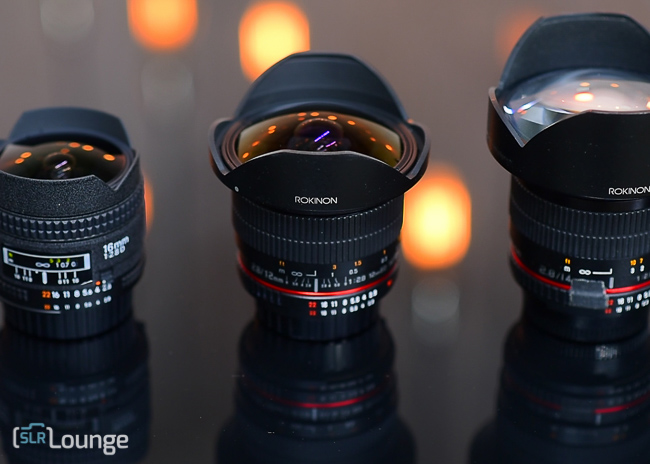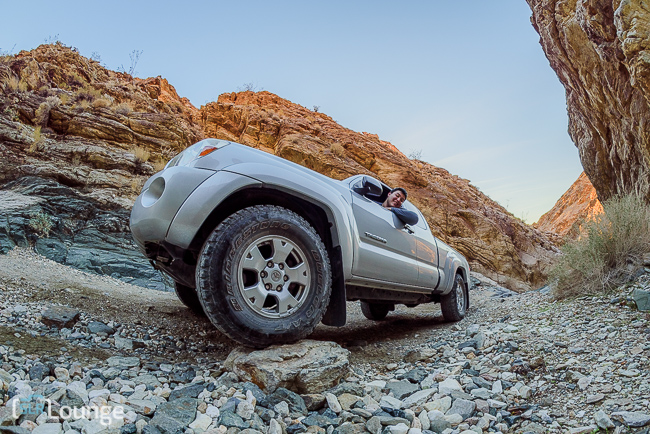
It’s time to review another lens that I’ve recently been very excited about! The Rokinon 12mm f/2.8 Fisheye (B&H, ~$499 – you support SLR Lounge when you shop via these links!) is a full-frame lens that offers an even wider angle of view than previous fisheye lenses. Despite being listed as a 180 degree diagonal fisheye lens, it somehow manages to squeeze in more angle of view both horizontally and vertically compared to other fisheye lenses, and it utterly destroys non-fisheye lenses as wide as 14mm, But don’t take my word for it, watch the video review below and then keep scrolling to see more sample images!
Who Should Buy This Lens, And What Is Its Competition?
One category of discussion that I like to add to all my reviews is, “Who is this lens made for, and what other lenses should you consider?”
Simply put, I like to review equipment that is designed for the types of things I like to do. This is why you will probably never see me write a one-star or two-star review, by the way. If I hate a camera or lens that much, I wouldn’t review it in the first place.
 Nikon D750, Rokinon 12mm f/2.8
Nikon D750, Rokinon 12mm f/2.8
1/90 sec @ f/16 & ISO 100
SLR Lounge Preset System
With that said, the Rokinon 12mm f/2.8 Fisheye is a good choice for anyone who is into the following:
Urbex / Caving Photographers
If you like shooting Urbex, (urban exploration) or caving, or anything along these lines, then you’ll love the Rokinon for two reasons: 1.) It’s sharp as heck, and 2.) It doesn’t cost $1500-$3000. I am NOT condoning trespassing, or any kind of dangerous activity, however if you were to engage in such things, the sorrow of getting your camera confiscated, lost, or destroyed is directly related to its cost. I’m just sayin’…
The only other lenses that get this wide, without breaking your bank, are the Sigma 12-24 f/4.5-5.6 (over a stop slower, and $950) and the Sigma 8-16 f/4.5-5.6 ($700), both of which are not nearly as sharp, and so distorted that they might as well be fisheyes.
 Nikon D750, Rokinon 12mm f/2.8, FotoPro C5C tripod
Nikon D750, Rokinon 12mm f/2.8, FotoPro C5C tripod
1/20 sec @ f/13 & ISO 100
SLR Lounge Preset System V6
 Nikon D5300, Rokinon 12mm f/2.8, FotoPro C5I tripod
Nikon D5300, Rokinon 12mm f/2.8, FotoPro C5I tripod
~275 layered 30 sec. exposures @ f/2.8 & ISO 100
Astro-Landscape Photographers
Simply put, for astro-landscape photographers, field curvature is a huge issue among almost every lens wider than 24mm. This Rokinon 12mm is one of the very few lenses in the 12-14mm range, period, and it is even more unique in having very good (low) field curvature. It’s not perfect, but at least it’s better than most of the other options out there! In fact, for my own astro-landscape photography, I’m probably going to sell my Rokinon 14mm 2.8 to help pay for this new 12mm.
Other lenses to consider in this range might include the Nikon 14-24 2.8, or the Rokinon 14mm 2.8, or the Tokina 16-28mm 2.8, or if you’re on a crop sensor, the Tokina 11-20mm f/2.8, Rokinon 10mm 2.8, or the Rokinon 8mm f/3.5 fisheye. Sigma also makes a couple fisheye lenses, however I haven’t had a chance to review them yet.
Extreme Action Sports / Journalism Photographers
If you find yourself frequently quoting Robert Capa, saying “if your photographs aren’t good enough, you’re not close enough,” then this is the lens for you. It is significantly wider than a 14mm lens, even when de-fisheye’d, and as a bonus similar to the risk-taking Urbex photographers, if you set this up on your remote camera and it gets taken out in a mountain bike / race car etc. accident, (or destroyed in a war zone?), you can at least remind yourself that it was one of the cheapest options on the market.
Other lenses to consider for this type of work might include a Rokinon or Sigma crop-sensor fisheye if you have a fast crop-sensor camera like the Canon 7D mk2 or the Pentax K-3.


Architectural / Interior / Real-Estate Photographers
If you find yourself in more “tame” shooting environments, but still needing extreme wide angles and the absolute best sharpness, this is a great lens to consider for interior photography and general architecture. At 12mm, this lens’ only real competition is the uber-expensive Canon 8-15mm f/4 fisheye zoom, ($1350) and the mythical, un-announced Canon 11-24mm f/4 non-fisheye, which is rumored to cost $3,000 and may not even actually exist.
Then again, it’s not like real-estate photographers are magically rolling in the dough, so if you’re on a budget, you’re back to square one.



The one aspect of this lens that I don’t hesitate to give a perfect score is its performance. Simply put, it is sharp, sharp, sharp! Not only that, but its images have plenty more to offer that few other fisheye lenses do: It has extremely low field curvature, in fact, its field curvature is almost perfectly flat all the way to the extreme corners, both at close distances and at infinity. By comparison, the Nikon 16mm f/2.8 fisheye is clearly front-focused by the rule of thirds mark, and worthlessly out of focus by the corners. Even if you focus past infinity on the Nikon, your extreme corners will never be sharp unless you stop down all the way to f/8 or f/11.
The Rokinon 12mm also has extremely low coma, decently low vignetting, nice sunstars, and decently low flare “dots.”







There’s only one thing I didn’t like about the Rokinon 12mm’s design, and that is that the hood is removable. This effectively means that almost the entire body of the lens is a spinning part, which makes the lens extremely difficult to mount or unmount from your camera, depending on if you shoot Nikon or Canon. I know that the Canon lens mount is a lot smoother in operation, but my Nikon DSLR bodies have always been a bit less of a smooth glide and this means you have to crank the focus ring all the way to one end so you can use it to lock the lens in place.
I would consider this design “flaw” to merit a two or three star rating, except for the fact that the removable hood does make that front element so darn easy to clean. Anyone who has had to clean the front element of a bulbous, fixed-hood lens will know what I’m talking about. So all in all, this may be a non-issue for Canon users who can still mount / unmount the lens by gripping the hood, (since it does lock into place quite tightly) and for those Nikon users who have to be careful not to drop the lens while mounting it, the benefit of easy cleaning is worth the drawback in my opinion.
This is a manual focus fisheye lens, so as far as “features” are concerned, you might think of it as a one-trick pony that few photographers should consider. However, as far as both fisheye and non-fisheye ultra-wide lenses are concerned, the Rokinon 12mm f/2.8 offers one thing that few others offer: an incredibly wide field of view, with incredible image quality. That, as a feature, means a lot.
 Rokinon 14mm
Rokinon 14mm
 Nikon 16mm f/2.8 Fisheye, de-fisheye’d using Fisheye Hemi
Nikon 16mm f/2.8 Fisheye, de-fisheye’d using Fisheye Hemi
 Rokinon 12mm f/2.8 Fisheye, de-fisheye’d using Fisheye Hemi
Rokinon 12mm f/2.8 Fisheye, de-fisheye’d using Fisheye Hemi
I’ll give this lens four stars, since it is a hands-down winner in the range of ultra-wide primes. Considering that it’s such a specialty lens, and lacks autofocus, I don’t think anybody would think it deserves a perfect score. I personally don’t care that it’s manual focus, however I know there will still be plenty of people who “need” it, and decide to get a different lens instead. For example, most casual and professional photojournalists would probably be much better off with an ultra-wide zoom, either the Nikon 16-35 f/4 VR or the Canon 16-35 f/4 L IS. Or, specialists who need f/2.8 and zoom capabilities more than an extra few mm on the wide end, ought to consider instead the Nikon 14-24 2.8 or the Tokina 16-28 2.8.

Unfortunately, I won’t be handing out five star reviews for quality to Rokinon just yet. Even though the build quality of this lens is quite impressive, it’s still very, well, plastic.

Like the Nikon 20mm f/1.8 G that I also reviewed recently, most buyers will consider the Rokinon 12mm’s build quality to be, simply put, sufficient. A handful of people always comment and say “What are you talking about, this thing is rock-solid!” and to them I would say, that’s great that you think so! Personally (as you saw in the video!), I put my gear through a little bit more abuse than most, and I would have preferred to see just a little bit more metal in the construction of this lens’ barrel and/or innards. Even if it meant adding $100-200 to the price! (See the value rating below).

At $499 for the Nikon version (which allows electronic aperture control, and saves EXIF data to images) and $492 for the Canon version (which does neither of those things, unfortunately), I have to say that this lens is a winner. The Nikon 16mm f/2.8 Fisheye costs ~$200 more, but to gain autofocus, you forfeit all kinds of sharpness and other image quality, off-center. The Sigma 15mm f/2.8 Fisheye is a closer alternate, at only ~$100 more, but is even less sharp than the Nikon. The Canon 15mm f/2.8 fisheye is also $200 more, but is discontinued and about as sharp as the Sigma, or worse.
So, like I said, the Rokinon is pretty much the only full-frame fisheye lens I can recommend, and I’d still recommend it even if it cost $100-200 more.
Additional Rokinon 12mm Fisheye Sample Images

 100% Crop, f/16
100% Crop, f/16


Conclusion

Given the abundance of ultra-wide lenses out there, it’s hard to call this lens a “must-have” lens. It is really only a must-have if you’ve ever shot with 16mm or 14mm and wished for more, and I’m certain that’s not very many people.
However, for those folks who do know what a huge difference just 1mm or 2mm can make, and crave every last one, there is no better lens that can match it. I’d highly recommend the Rokinon 12mm f/2.8 Fisheye to anybody who is considering a fisheye or super-ultra-wide lens!
Happy clicking,
=Matt=
Matthew Saville
Follow his wilderness nightscape adventures on Instagram: instagram.com/astrolandscapes





Get Connected!